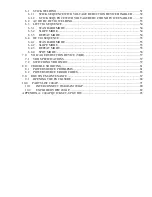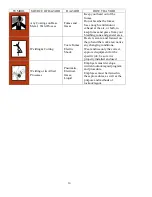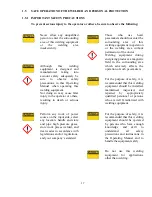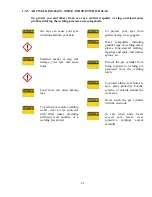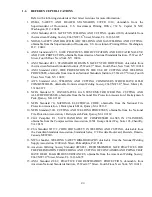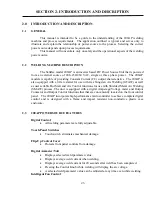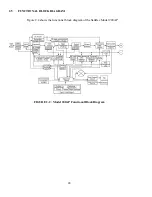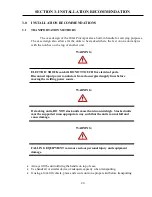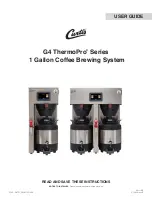
20
1.5.4 FIRE AND EXPLOSIONS
To prevent fire, explosion, or rupture, be sure to observe the following precautions
Spatter or hot base metals
produced during and
immediately after the welding
processes may cause fire.
Poor connections of cables or
defective contacts in any current
path on the base metal such as
steel
frame
may
cause
overheating due to conducting
current, resulting in fire.
Explosion can be caused by the
welding
arc
produced
on
containers that may have held
combustibles such as gasoline.
Rupture can be caused by
welding enclosed tanks or pipes.
Keep combustibles away from
scattered
spatter.
Cover
combustibles that cannot be
removed with incombustible
shields.
Do not weld in the vicinity of
flammable gases.
Keep
hot
base
metals
immediately after the welding
processes
away
from
combustibles.
When welding ceiling, floor or
wall,
remove
combustibles
hidden adjacent to them.
Tighten
cable
connections
securely and insulate them.
Connect work lead so that it is
positioned as close to the part
welded as possible.
Do not weld a gas pipe that may
have held any gas or an
enclosed tank or pipe
Have a fire extinguisher handy
in the vicinity of the welding
area
in
preparation
for
emergency.
Summary of Contents for SANARG 200AP
Page 2: ......
Page 4: ......
Page 8: ......
Page 24: ...24 PAGE LEFT INTENTIONALLY BLANK ...
Page 35: ...35 Figure 3 2 Electrical Input Connections 200AP ...
Page 60: ...60 PAGE LEFT INTENTIONALLY BLANK ...
Page 66: ...66 PAGE LEFT INTENTIONALLY BLANK ...
Page 79: ...79 PAGE LEFT INTENTIONALLY BLANK ...
Page 80: ...80 10 1 INTERCONNECT DIAGRAM 200AP ...
Page 81: ...81 ...
Page 82: ...82 10 2 EXPLODED VIEW 200AP ...
Page 83: ...83 ...
Page 84: ...84 PAGE LEFT INTENTIONALLY BLANK ...
Page 89: ...PAGE LEFT INTENTIONALLY BLANK ...


